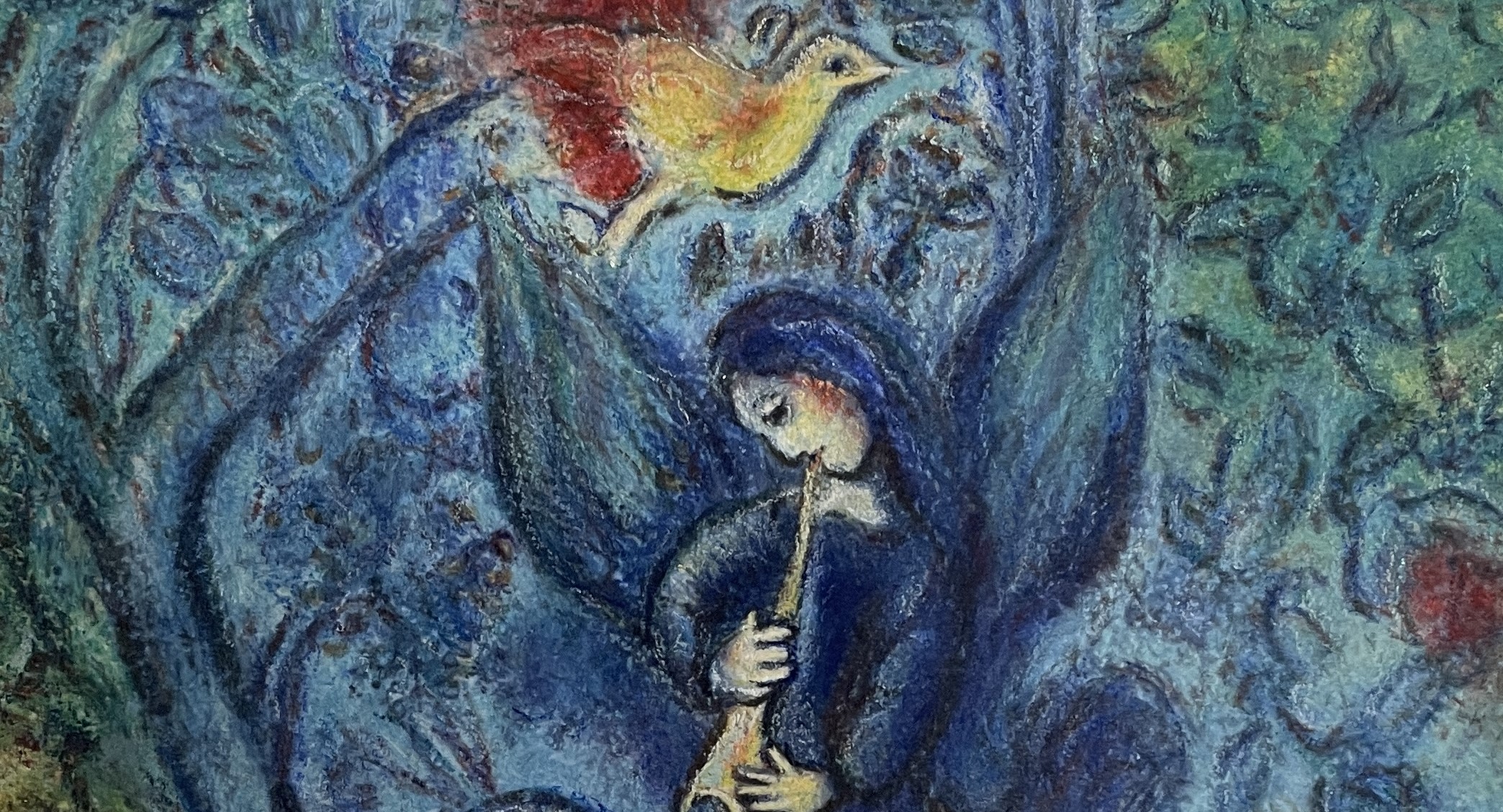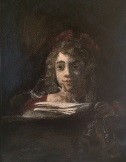日本語-Englishー台灣華語
レンブラント・ファン・レイン「ティトスの肖像」
「光と影の画家」と称されるレンブラントの一生は、その絵画のように、栄華と困窮に二分される人生だった。皮肉なことにレンブラントの絵は、困窮を重ねるほどに輝きを増している。粉引き屋の10人兄弟の末っ子として生まれたレンブラントは、若くして人気画家となる。今もレンブラントハウスとして往時を偲ぶことができる大きな邸宅をアムステルダムに構えていた。
レンブラントは愛妻サスキアとの間に4人の子供をもうけたが、最後に生まれたティトスを除いて幼いうちに亡くしてしまう。妻サスキアもティトスを生んだ翌年には亡くなってしまう。サスキアの病死後、彼の人生の歯車は狂っていく。自らの能力で勝ち得た成功に自信を深めていたレンブラントは、将来の収入を楽観的に当て込んで、収入以上の買い物をしてしまう。紛い物の鎧では我慢できず、金に糸目をつけずに本物を買ってしまう。ラファエロの絵があると知るや、買わずにはいられない。それら全ては作品の中に昇華されているが、50歳で経済的には破綻してしまう。家や財産はすべて競売にかけられ、それでも彼の借金を帳消しにするには足りなかった。その時ティトスは15歳。そのティトスは父親から美術の手ほどきを受け、いくつかの作品を残している。成人してからは、晩年の画家を支えた愛人ヘンドリッケとともに美術商となり、破産後の父を支えている。レンブラントにとってティトスは、まさに闇の中にさす一筋の光だったに違いない。運命は過酷にも、そのティトスさえレンブラントの死の前年に連れ去ってしまう。肖像画家として傑出したレンブラントではあるが、彼の本領は身近な家族を描く時に、何よりも現れている。レンブラントは息子のティトスを小さい頃から何度も描いているが、そのほとんどが傑作である。この作品はその中でもとりわけ愛らしい。
この絵のティトスは10歳を少し過ぎたあたりであろうか。私がこの絵をはじめて観た時、私の息子も8歳だった。私は机に寄り掛かるティトスの肖像を描くことにする。 この絵を描いていると、レンブラントの息子に対する有り余る愛情と、明るい未来を感ぜずにはいられない。聡明で思慮深い自分の息子を誇らしく、確信を持って描いているのを強く感じる。額と髪に強いハイライトが当てられ、知性を暗示している。机によって二分された画面の中央に大きく三角形に描かれているティトスは揺るぎない。左右の袖口と首元と頭上の帽子が赤く描かれ、三角形の構図を強調している。ペンケースとインク壺を指にぶら下げ、揺ら揺らともてあそぶ少年は、ふと空間の一点を凝視して動きを止めている。それはまるで永遠の愛を画面に封印しているかのようだ。レンブラントの絵は、実物を徹底的に凝視し、写生しながらも、驚く程大胆なタッチで描かれている。劇的な明暗描写に更なる命を与えている。私はティトスの肖像を描きながら、なぜかマネの黒い帽子をかぶったベルトモリゾの肖像を思い出すのだった。レンブラントの絵画は時代を大きく先取りした印象派にも連なる近代的絵画なのだ。 レンブラントは、図らずも破産によって人生の虚飾から自由となり、いやがうえにも余分なものを排除させられた。画家はただ光と陰の中に身を沈め、人間の内面を大胆かつ細やかに描きだすことに専念する。晩年の作品は観る者の心に深く入り込み、人生の何たるかを悟らせる。生きる事の苦々しさと悲しさ。世俗から超越したところにある崇高な境地。それは全てを失い、全てを諦め、全てが消えかかる絶望の淵にあってもなお、人間とは何かを描き出そうとした画家によって到達した芸術である。画家は若くして成功してよいのだろうか。世俗的成功と芸術的境地はとかく一致しないものだ。神はレンブラントにかくも過酷な試練を与え、その見返りにかくも不滅の絵画を残した。私はそこに人生の真理を垣間見るのである。
Titus at his desk
Rembrandt, known as ‘the painter of light and shadow,’ led a life as divided as his paintings between splendor and poverty. Ironically, the more Rembrandt faced adversity, the brighter his paintings shone. Born the youngest of ten siblings to a miller, Rembrandt quickly became a popular artist in his youth. He owned a large mansion in Amsterdam, which can still be visited today as the Rembrandt House. Rembrandt fathered four children with his beloved wife Saskia, but except for his last-born, Titus, they all died young. Saskia herself passed away the year after Titus was born. Her death from illness sent his life into disarray. Confident in his abilities and optimistic about future earnings, Rembrandt spent beyond his means. He could not settle for imitation armor, sparing no expense on the genuine article. He could not resist purchasing a painting once he learned it was by Raphael. All of these, though, were sublimated into his work, but by the age of 50, he was financially ruined. His house and possessions were auctioned off, yet it was not enough to cover his debts. At that time, Titus was 15 years old. Titus, having been taught art by his father, left behind several works. As an adult, he became an art dealer with Rembrandt’s lover, Hendrickje, supporting his father after bankruptcy. For Rembrandt, Titus was undoubtedly a ray of light in the darkness. Fate cruelly took even Titus away the year before Rembrandt’s death. Though Rembrandt was an outstanding portrait artist, his true domain was in depicting his close family, more than anything else. He painted his son Titus many times from a young age, most of which are considered masterpieces. Among these, one is particularly endearing. This painting of Titus might be from when he was just over ten years old. When I first saw this painting, my own son was eight years old.
I decided to draw the portrait of Titus leaning on a desk. While drawing this, I couldn’t help but feel Rembrandt’s overflowing love for his son and a bright future. I strongly sensed him drawing his son, who is smart and thoughtful, with pride and conviction. The strong highlights on the forehead and hair suggest intelligence. Titus, drawn prominently in the center of the canvas divided by a desk, forms a solid triangle. The red painted on the cuffs, neckline, and hat above his head emphasizes this triangular composition. The boy, dangling a pen case and ink bottle from his fingers and toying with them, stops suddenly to gaze at a point in space, as if sealing eternal love into the canvas. Rembrandt’s paintings are drawn with an astonishingly bold touch, while closely observing and sketching from life, giving further life to dramatic chiaroscuro. While drawing Titus’s portrait, I found myself reminded of Berthe Morisot wearing a black hat by Manet. Rembrandt’s paintings, indeed, were modern art that significantly preceded the Impressionist era.
Rembrandt, unwittingly freed from the pretensions of life by bankruptcy, was forced to eliminate the superfluous. The artist devoted himself to immersing in light and shadow, boldly and delicately depicting the human psyche. His late works deeply resonate with viewers, enlightening them on the essence of life—the bitterness and sadness of living, a sublime realm transcending the mundane, reached by an artist who tried to depict what it means to be human even in the depths of despair, having lost everything, resigned to everything, as everything fades away. Should an artist succeed young? Worldly success and artistic achievement seldom align. God gave Rembrandt such harsh trials and, in return, left us with immortal paintings. In them, I glimpse the truths of life.
雷門布蘭特·范·萊因《提圖斯肖像》
被稱為“光與影的畫家”的雷門布蘭特,他的一生就像他的畫作一樣,被榮華與貧困二分。諷刺的是,雷門布蘭特的畫作,在貧困加重的同時,卻愈發閃耀。作為粉碎工的十個兄弟中的最小的一個,雷門布蘭特年輕時就成為了一位受歡迎的畫家。他在阿姆斯特丹擁有一座大宅子,現在作為雷門布蘭特之家以追憶往昔。雷門布蘭特與他的愛妻薩斯基婭育有四個孩子,但除了最後出生的提圖斯外,其他的孩子都在幼年時去世。薩斯基婭在提圖斯出生的第二年也去世了。在薩斯基婭去世後,他的人生開始走向混亂。雷門布蘭特對於自己通過能力獲得的成功充滿自信,對未來的收入過於樂觀,進行超出收入的消費。他對假冒的盔甲不滿意,不惜一切代價購買真品。得知有拉斐爾的畫作,便無法抑制購買的欲望。這些都被昇華到了他的作品中,但到了50歲時經濟上已完全破產。房子和財產都被拍賣,但仍不足以清償他的債務。當時提圖斯15歲。提圖斯從父親那裡學到了美術,留下了一些作品。成年後,他成為了一名藝術商,與父親晚年的愛人亨德里克一起,支持破產後的父親。對雷門布蘭特來說,提圖斯無疑是黑暗中的一線光明。命運殘酷地在雷門布蘭特去世的前一年將提圖斯帶走。雷門布蘭特雖然是一位杰出的肖像畫家,但當他畫自己親近的家人時,他的真正才能才最為顯現。雷門布蘭特多次畫了他的兒子提圖斯,這些畫作幾乎都是傑作。這幅作品尤其可愛。這幅畫中的提圖斯大概剛過10歲。我第一次看到這幅畫時,我的兒子也是8歲。我決定畫下倚靠在書桌上的提圖斯的肖像。
畫這幅畫時,我不禁感受到雷門布蘭特對他兒子的深情,以及對明亮未來的感受。我強烈地感覺到他以一種聰明而深思熟慮的方式,自豪且堅定地描繪自己的兒子。額頭和頭髮上的強烈高光暗示了智慧。畫面被書桌二分,中央大大地以三角形描繪了提圖斯,非常穩固。左右袖口、領口和頭上的帽子被描繪成紅色,強調了三角形的構圖。手指上掛著筆盒和墨水瓶,隨意擺弄的少年,突然凝視空間的一點,動作停止。就像是在畫面中封存了永恆的愛。雷門布蘭特的畫作,是通過深入觀察實物,一邊寫生一邊以驚人的大膽筆觸進行繪畫。劇烈的明暗對比賦予了畫作更多的生命。畫提圖斯的肖像時,我不知為何想起了穿著黑帽的貝爾托·莫里索的肖像,這似乎預示了雷門布蘭特的畫作是近代印象派的先驅。
雷門布蘭特因不幸的破產,無意中從人生的虛榮中解脫出來,不得不去除多餘的事物。畫家只是沉浸在光與影中,專注於大膽細膩地描繪人的內心。他晚年的作品深入觀者的心靈,讓人領悟到人生的真諦。生活的苦澀與悲哀,超越世俗的崇高境界,即使在失去一切、放棄一切、一切都在消逝的絕望中,仍努力描繪人的本質。一位藝術家年輕時就取得成功是否好?世俗的成功與藝術的境界往往不一致。神賜予雷門布蘭特如此嚴峻的試煉,作為回報,留下了不朽的畫作。我在其中瞥見了人生的真理。


